Fajita Chicken Skillet Recipe
Are you looking for a quick and delicious dinner that’s packed with flavor? Look no further than this mouth-watering fajita chicken skillet recipe. Perfect for a busy weeknight, this dish is not only easy to prepare but also brings the vibrant taste of a Mexican-inspired meal right to your table.
This recipe is a game-changer for anyone seeking a satisfying meal without spending hours in the kitchen. With its blend of savory spices, tender chicken, and crisp vegetables, it’s sure to become a staple in your culinary repertoire.
Table of Contents
Key Takeaways
- Quick and easy dinner solution
- Packed with flavor and nutrients
- Perfect for busy weeknights
- Easy to customize with your favorite ingredients
- Mexican-inspired flavors for a delicious twist
- Great for meal prep or a family dinner
The Appeal of Fajita Chicken Skillet
If you’re looking for a dish that’s both easy to prepare and packed with flavor, Fajita Chicken Skillet is an excellent choice. This one-pot wonder combines the savory taste of chicken with the vibrant flavors of bell peppers and onions, all wrapped up in a spicy fajita seasoning.
What Makes This Dish Special
The easy fajita chicken recipe stands out due to its quick preparation time and the ability to customize it according to your taste preferences. You can add your favorite vegetables or adjust the level of spiciness to suit your palate. The result is a delicious and satisfying meal that’s perfect for any night of the week.
Origins of Fajitas in American Cuisine
Fajitas have a rich history that dates back to Mexican cuisine, but they have become a staple in American cooking as well. The origins of fajitas in the United States can be traced back to the southwestern region, where Mexican cuisine has had a significant influence. Over time, the traditional recipe has been adapted to incorporate local flavors and ingredients, resulting in the chicken fajita recipe we know and love today.
| Key Ingredients | Role in the Dish |
|---|---|
| Chicken Breast | Provides protein and absorbs flavors well |
| Bell Peppers | Adds crunch and sweetness |
| Onions | Contributes to the depth of flavor |
| Fajita Seasoning | Gives the dish its characteristic flavor |
Essential Ingredients for the Perfect Fajita Chicken Skillet
Crafting an irresistible fajita chicken skillet starts with gathering the right ingredients. The quality and combination of these ingredients will elevate your dish from ordinary to extraordinary, ensuring a flavorful and satisfying meal.
Selecting the Right Chicken
When it comes to chicken fajita skillet recipes, the type of chicken you choose can significantly impact the final result. You have the option between boneless and bone-in chicken, each with its own advantages.
Boneless vs. Bone-in Options
Boneless chicken breasts or thighs are popular for fajitas because they cook quickly and are easier to slice into thin strips. On the other hand, bone-in chicken can add more flavor to your dish, as the bones act as a conductor of heat, cooking the meat more evenly. However, it requires a bit more cooking time and effort to debone it after cooking.
Fresh Vegetables That Make a Difference
Fresh vegetables are a crucial component of a delicious chicken fajita skillet meal. Bell peppers, onions, and sometimes tomatoes are the staples. The vibrant colors and varied textures of these vegetables not only add visual appeal but also contribute to the overall flavor profile.
Bell Pepper Varieties and Their Flavors
Bell peppers come in a variety of colors, including green, red, yellow, and orange. Each color has a slightly different flavor profile, with green being more bitter and the others sweeter. Using a mix of colors can add depth to your fajita skillet.
| Vegetable | Flavor Profile | Cooking Time |
|---|---|---|
| Green Bell Pepper | Crisp, slightly bitter | 5-7 minutes |
| Red Bell Pepper | Sweet, slightly smoky | 5-7 minutes |
| Onion | Sweet, caramelized | 7-10 minutes |
Spices and Seasonings for Authentic Flavor
The right spices and seasonings are what give your fajita chicken skillet its authentic flavor. A homemade fajita seasoning blend can make all the difference, typically consisting of a mix of chili powder, cumin, garlic powder, and other spices. Adjusting the blend to your taste can elevate the dish, making it a true one-pan fajita chicken delight.
Kitchen Equipment You’ll Need
Before you start cooking your fajita chicken skillet, it’s essential to have the right tools. The right equipment can make a significant difference in the cooking process, ensuring your dish turns out flavorful and perfectly cooked.
Choosing the Ideal Skillet
The skillet is the most critical piece of equipment for cooking your fajita chicken skillet. A cast-iron or stainless steel skillet is ideal because it retains heat well and can achieve a good sear on the chicken and vegetables. Look for a skillet that is large enough to hold all your ingredients in a single layer.
- Cast-iron skillets for heat retention
- Stainless steel skillets for durability
- Non-stick skillets for easy cleaning
Other Helpful Tools
Apart from the skillet, there are other tools that can make cooking your fajita chicken skillet easier. These include a sharp chef’s knife for cutting the chicken and vegetables, a cutting board for preparation, and tongs or a spatula for stirring and serving.
- Sharp chef’s knife for precise cutting
- Cutting board for safe preparation
- Tongs or spatula for easy stirring
Preparing Your Ingredients
The key to a great fajita chicken skillet lies in the preparation of its ingredients. Proper preparation not only ensures that your dish is flavorful but also makes the cooking process smoother and more enjoyable. In this section, we’ll guide you through the steps to prepare your ingredients for a delicious homemade fajita chicken dish.
Slicing Techniques for Chicken
To achieve tender and juicy chicken in your easy chicken fajitas, it’s crucial to slice it correctly. Slice the chicken against the grain into thin strips, about 1/4 inch thick. This technique helps the chicken cook evenly and quickly, ensuring it remains tender. Make sure to use a sharp knife to get clean cuts and to prevent the chicken from tearing.
Cutting Vegetables for Even Cooking
Cutting your vegetables uniformly is vital for achieving even cooking in your flavorful fajita chicken skillet. Bell peppers should be sliced into thin strips, and onions should be cut into similar-sized pieces to ensure they cook at the same rate. You can also cut the vegetables a bit larger if you prefer them to retain some crunch.
Making Homemade Fajita Seasoning
Creating your own fajita seasoning blend is simple and allows you to customize the flavors to your liking. Mix together chili powder, cumin, paprika, garlic powder, onion powder, salt, and pepper. You can adjust the proportions based on your taste preferences. For a spicy kick, consider adding some cayenne pepper or red pepper flakes to your homemade fajita seasoning.
Storing Your Homemade Seasoning
Store your homemade fajita seasoning in an airtight container to preserve its flavors. Keep it in a cool, dry place, away from direct sunlight. This way, you’ll have a ready-to-use seasoning blend for your future fajita recipes.
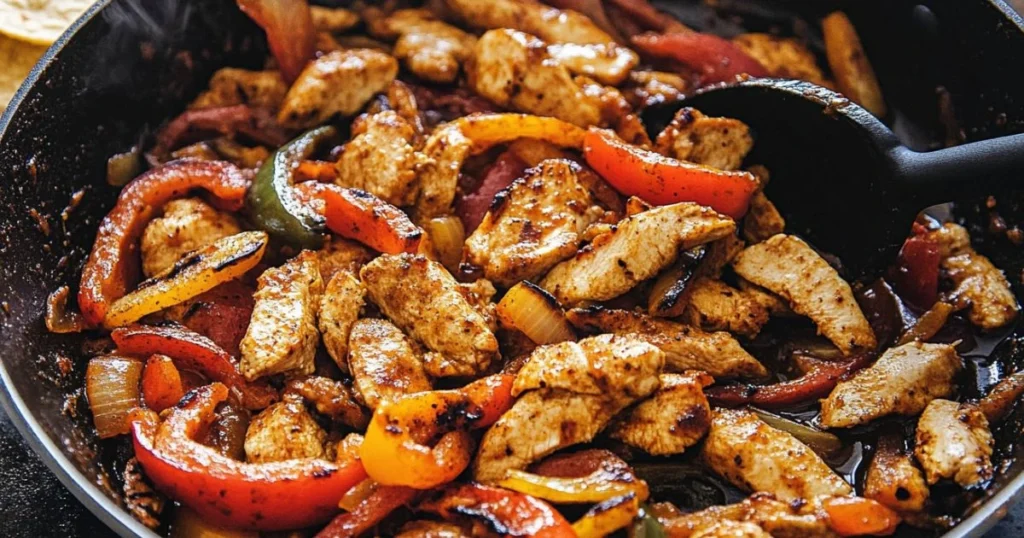
Mastering the Fajita Chicken Skillet: Step-by-Step Instructions
The key to a perfect fajita chicken skillet lies in its preparation and cooking technique, which we’re about to break down for you. Cooking a quick fajita chicken dinner is all about efficiency and flavor. By following these steps, you’ll be able to create a dish that’s both delicious and satisfying.
Marinating the Chicken
To start, you’ll need to marinate the chicken. This step is crucial for infusing the chicken with the bold flavors characteristic of a best fajita chicken recipe. Mix your chosen marinade ingredients, including lime juice, olive oil, garlic, and spices, in a bowl. Add the sliced chicken, ensuring it’s fully coated, and let it marinate for at least 30 minutes.
Sautéing the Vegetables
While the chicken is marinating, you can begin preparing the vegetables. Sautéing the vegetables is a critical step in making one-pan chicken fajitas. Heat a large skillet over medium-high heat and add a tablespoon of oil. Once hot, add your sliced onions and bell peppers, cooking until they’re tender and slightly charred.
Combining and Finishing the Dish
After the vegetables are cooked, add the marinated chicken to the skillet, cooking until it’s fully cooked and the flavors have melded together. This is where the magic happens, turning your ingredients into a cohesive, flavorful dish. Serve the fajita chicken skillet hot, garnished with fresh cilantro, lime wedges, and your choice of accompaniments, making it a truly quick fajita chicken dinner that’s ready in no time.
By following these steps, you’ll be able to create a delicious fajita chicken skillet that’s sure to become a staple in your culinary repertoire. The beauty of this dish lies in its simplicity and the ability to customize it to your taste preferences.
Tips for Achieving Restaurant-Quality Results
To elevate your fajita chicken skillet to a restaurant-quality dish, focus on mastering a few key techniques. Achieving a flavorful chicken skillet that’s reminiscent of a professional chef’s creation involves understanding the nuances of cooking and the importance of quality ingredients.
Getting the Perfect Sear
A perfect sear on the chicken is crucial for a delicious fajita recipe. It not only enhances the visual appeal but also locks in the juices, making the chicken more tender and flavorful. To achieve this, ensure your skillet is hot enough before adding the chicken.
Managing Heat Levels
Managing heat levels is critical when searing chicken. High heat is necessary for a good sear, but it requires careful monitoring to prevent burning. Adjust your stove to a high setting, but be prepared to adjust as needed.
Balancing Flavors
Balancing flavors is another key aspect of creating a flavorful chicken skillet. This involves not just the seasoning but also the harmony between the chicken, vegetables, and spices. Taste as you go and adjust the seasoning to achieve a balanced flavor profile.
By mastering these techniques, you’ll be well on your way to creating a delicious fajita recipe that rivals your favorite restaurant’s. Remember, practice makes perfect, so don’t be discouraged by initial attempts.
Delicious Variations of Fajita Chicken Skillet
The beauty of the Fajita Chicken Skillet lies in its adaptability to different flavors and dietary needs. You can easily modify this recipe to create a variety of dishes that cater to your taste preferences or dietary requirements.
Spicy Jalapeño Version
For those who enjoy a bit of heat, the Spicy Jalapeño Fajita Chicken Skillet is a great option. Simply add sliced jalapeños or serrano peppers to the skillet along with the chicken and vegetables. You can also sprinkle some red pepper flakes for an extra kick. This variation adds a bold flavor to the dish, making it a quick fajita meal that’s both spicy and satisfying.
Creamy Fajita Chicken Skillet
If you prefer a milder and creamier version, you can transform the Fajita Chicken Skillet into a rich and indulgent meal. Add a splash of heavy cream or sour cream towards the end of cooking, and stir in some shredded cheese. This creamy variation is perfect for those who enjoy a comforting, healthy fajita chicken recipe with a luxurious twist.
Low-Carb and Keto-Friendly Options
For individuals following a low-carb or keto diet, the Fajita Chicken Skillet can be easily adapted. Replace the traditional tortillas with low-carb alternatives or serve the skillet over cauliflower rice. Ensure that the vegetables used are low in carbs, and be mindful of the seasonings to avoid any hidden sugars. This version remains a quick fajita meal while adhering to dietary restrictions.
Vegetarian and Vegan Adaptations
Vegetarians and vegans can also enjoy the flavors of the Fajita Chicken Skillet by making a few simple substitutions. Replace the chicken with tofu, tempeh, or seitan, and load up on a variety of colorful vegetables. For a vegan version, ensure that the seasoning is free from animal-derived ingredients. These vegetarian fajita adaptations offer a delicious and satisfying meal that everyone can enjoy.
By experimenting with these variations, you can keep the Fajita Chicken Skillet recipe fresh and exciting, ensuring that it never becomes boring. Whether you’re in the mood for something spicy, creamy, or entirely plant-based, this versatile dish can be tailored to your preferences.
Serving Suggestions and Accompaniments
The way you present and accompany your fajita chicken skillet can make a significant difference in the overall meal. Serving suggestions can range from traditional fajita sides to creative serving ideas, all of which can be paired with a variety of beverages to enhance the dining experience.
Traditional Fajita Sides
Traditional fajita sides include warm flour or corn tortillas, Mexican rice, and refried beans. You can also add some grilled or sautéed vegetables like bell peppers and onions to complement the dish. For a more authentic experience, consider adding some freshly made guacamole or a simple green salad.
Creative Serving Ideas
To add a twist to your fajita chicken skillet, consider serving it in individual cast-iron skillets or ramekins for a personalized touch. You can also get creative with the toppings, offering a variety of salsas, sour cream, and shredded cheese. For a family-style presentation, arrange the skillet on a large platter or board, surrounded by your chosen sides and garnishes.
Family-Style Presentation Tips
For a family-style presentation, use a large, decorative platter or a wooden board. Arrange the fajita chicken skillet in the center, surrounded by bowls of your chosen sides. Garnish with fresh cilantro, lime wedges, and sliced avocados to add color and freshness.
Beverage Pairings
For beverage pairings, consider a refreshing margarita or a crisp beer to complement the bold flavors of the fajita chicken skillet. Iced tea or infused water with lime and mint can also provide a lighter option. For a non-alcoholic choice, a sparkling water with a splash of citrus can cleanse the palate between bites.
Storing and Reheating Your Fajita Chicken Skillet
Leftover Fajita Chicken Skillet can be just as delicious as when it’s freshly cooked, provided you store and reheat it properly. Ensuring that your leftovers remain safe to eat and flavorful is a matter of following a few simple steps.
Proper Storage Methods
To keep your Fajita Chicken Skillet fresh, it’s crucial to store it in an airtight container. This prevents moisture and other flavors from affecting the dish. You can store it in the refrigerator for up to three days. For longer storage, consider freezing it.
Freezing Guidelines
When freezing, make sure to use a freezer-safe container or freezer bag, removing as much air as possible before sealing to prevent freezer burn. Label the container with the date, and use within three months for the best quality.
Reheating Without Losing Flavor
Reheating your Fajita Chicken Skillet can be done on the stovetop or in the microwave. For stovetop reheating, place the skillet over medium heat, adding a small amount of oil or water if the dish seems dry. Stir occasionally until heated through. If using a microwave, cover the dish with a microwave-safe lid or plastic wrap to retain moisture, and heat in short intervals, stirring between each heating.
By following these guidelines, you can enjoy your Fajita Chicken Skillet for days after it’s been cooked, with minimal loss of flavor or texture.
Nutritional Information and Dietary Considerations
Understanding the nutritional content of your Fajita Chicken Skillet is crucial for maintaining a balanced diet. This dish, when prepared with the right ingredients, can be a healthy and nutritious meal option.
Calorie and Macronutrient Breakdown
A typical serving of Fajita Chicken Skillet contains approximately 350-400 calories, with a balance of proteins, fats, and carbohydrates. The chicken breast provides a significant amount of protein, while the vegetables add fiber and vitamins. The calorie count can vary based on the amount of oil used and the specific ingredients.
| Nutrient | Amount per Serving |
|---|---|
| Calories | 375 |
| Protein | 35g |
| Fat | 15g |
| Carbohydrates | 20g |
| Fiber | 5g |
Making Your Fajita Chicken Skillet Healthier
You can make several adjustments to enhance the nutritional value of your Fajita Chicken Skillet. Using leaner proteins, increasing the variety of vegetables, and reducing the amount of oil are effective ways to make the dish healthier.
Lower-Sodium Adaptations
To reduce sodium, you can limit the amount of salt added and use low-sodium alternatives for ingredients like soy sauce or broth. Additionally, increasing the proportion of fresh vegetables can help balance the flavors without adding extra salt.
Accommodating Dietary Restrictions
The Fajita Chicken Skillet can be adapted to suit various dietary needs. For a low-carb version, you can reduce or eliminate the serving with tortillas or rice. For gluten-free diets, ensure that the seasonings and sauces used are gluten-free. Vegetarian or vegan versions can be made by substituting the chicken with plant-based proteins like tofu or tempeh.
Conclusion
The Fajita Chicken Skillet recipe is a versatile and quick weeknight dinner solution that combines flavorful chicken, fresh vegetables, and authentic spices.
You can easily customize this dish to suit your taste preferences and dietary needs. With the steps outlined in this article, you’re equipped to create a delicious and satisfying meal that’s perfect for any night of the week.
The fajita chicken skillet recipe is not only easy to prepare but also offers a restaurant-quality experience in the comfort of your own home. Try this recipe tonight and discover a new favorite way to enjoy a quick weeknight dinner that’s both healthy and delicious.
FAQ
What is a Fajita Chicken Skillet?
A Fajita Chicken Skillet is a one-pan dish that combines chicken, vegetables, and spices, typically associated with Mexican cuisine, cooked together in a skillet.
How do I make a quick Fajita Chicken dinner?
To make a quick Fajita Chicken dinner, prepare your ingredients, including slicing the chicken and vegetables, and have your fajita seasoning ready. Then, cook everything together in a skillet.
Can I use homemade Fajita seasoning in this recipe?
Yes, you can use homemade Fajita seasoning. Making your own seasoning allows you to customize the flavors to your liking and avoid any additives found in store-bought mixes.
What are some healthy Fajita Chicken recipe options?
To make a healthier Fajita Chicken recipe, consider using leaner cuts of chicken, plenty of vegetables, and controlling the amount of oil used. You can also adjust the seasoning to reduce sodium.
How do I store leftovers of the Fajita Chicken Skillet?
Store leftovers in an airtight container in the refrigerator. You can also freeze the dish for later use, following proper freezing guidelines to maintain flavor and safety.
Can I make a low-carb or keto version of the Fajita Chicken Skillet?
Yes, you can make a low-carb or keto version by focusing on the protein and vegetable components, reducing or eliminating high-carb ingredients, and being mindful of the seasonings used.
What are some creative serving ideas for Fajita Chicken Skillet?
Consider serving the Fajita Chicken Skillet with traditional sides like tortillas, rice, or beans, or get creative with alternatives like low-carb wraps or cauliflower rice. You can also present it family-style.
How do I reheat the Fajita Chicken Skillet without losing flavor?
To reheat without losing flavor, use a skillet over medium heat, adding a bit of oil or water if necessary to prevent drying out. You can also reheat it in the microwave, covered, to retain moisture.
What are some beverage pairings that go well with Fajita Chicken Skillet?
Popular beverage pairings include margaritas, Mexican beers, iced tea, or infused water with lime and mint. Choose a drink that complements the spicy and savory flavors of the dish.
Can I make a vegetarian or vegan version of the Fajita Chicken Skillet?
Yes, you can make a vegetarian or vegan version by substituting the chicken with plant-based protein sources like tofu, tempeh, or seitan, and adjusting the seasonings as needed.


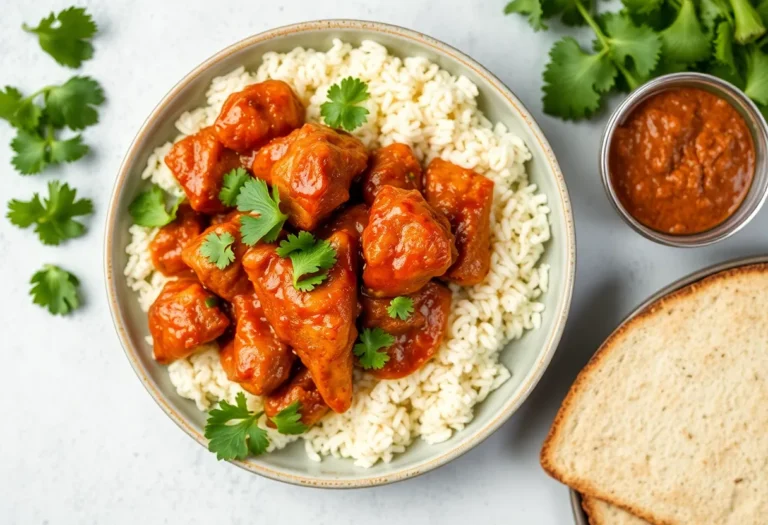
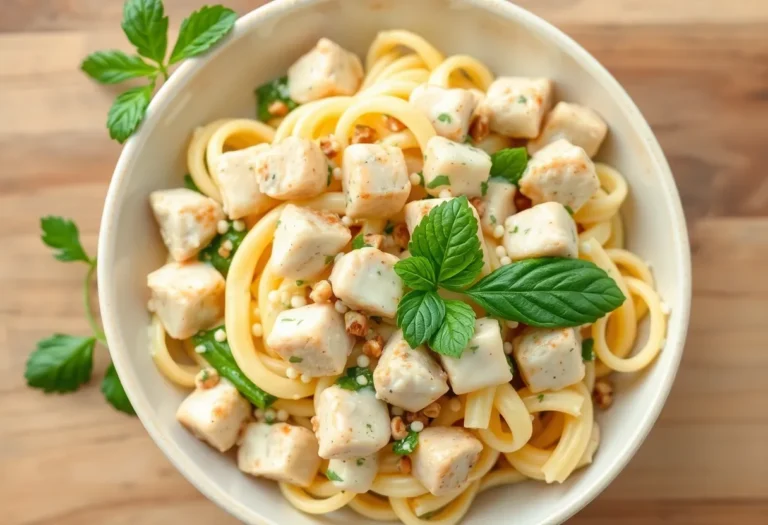
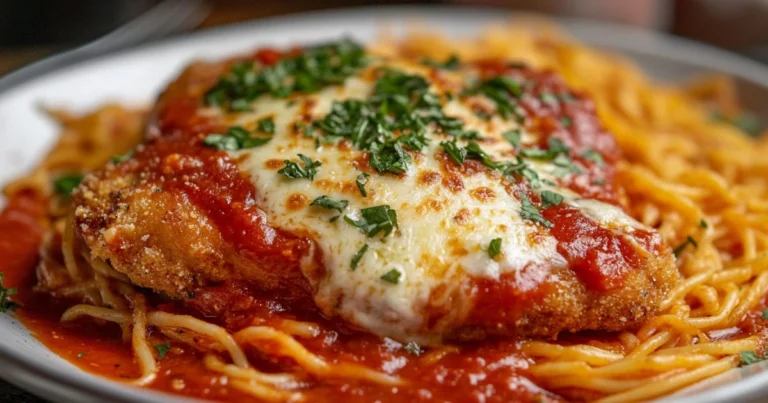
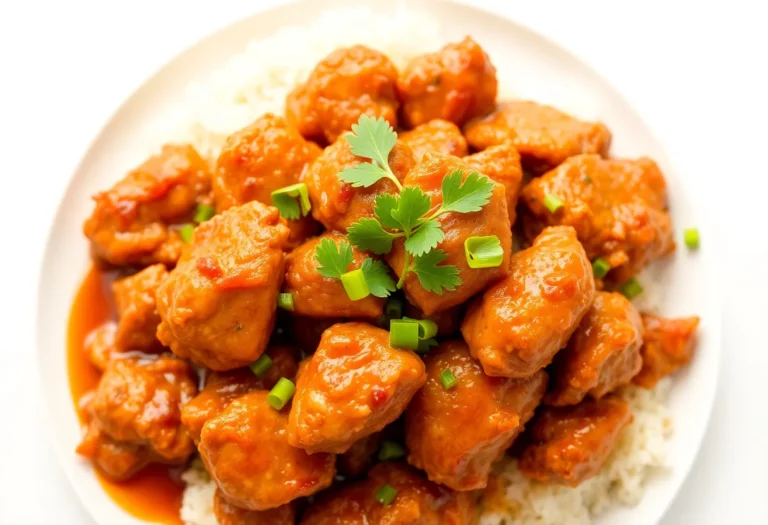

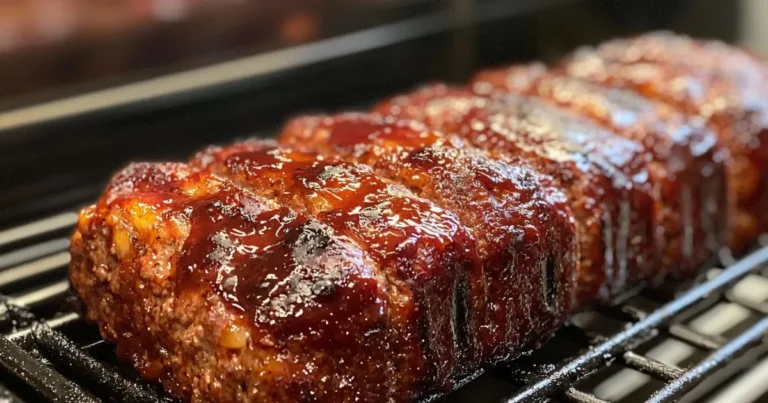
One Comment
Comments are closed.